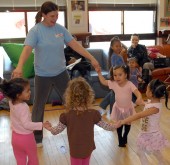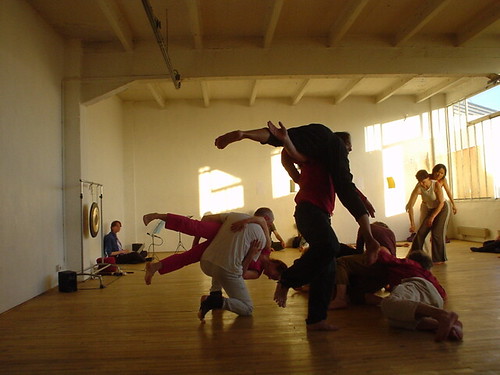Creative Dance for Children

A creative dance class designed for children will help them prepare for a future in dance and other physical activities. In class, dancers are provided with the opportunity to use their imagination, creativity, and self expression while developing skills that are the building blocks of all movement and dance activities. They learn good listening skills, proper classroom etiquette, and how to move safely with other children, as well as learning respect and tolerance for others. Young children enrolled in creative dance learn and practice basic motor skills (locomotor and nonlocomotor movements) and use a variety of music and props which enhance self-awareness, control and coordination. These experiences are offered with consistent structure and provide many opportunities for mastering skills. This creates a sense of predictability as well as a safe place for the younger child to learn cooperation, increase self-esteem, and attain a sense of accomplishment.
Early childhood educators encourage preschool and kindergarten programs that are designed for the mind of a young child because it has been found that most children under 7 or 8 are not ready to be taught focused subjects while sitting behind a desk for long periods. Dance is no different. To benefit from the intense focus and concentration of a ballet class which is very structured and contains extended periods at the barre, it requires a physical and mental maturity not available to most younger children. Children under 7 or 8 are typically neither interested in nor ready for this kind of learning. Creative dance is perfectly suited to offer preparation of the mind and body for a younger student, gradually helping them to learn self-control and increase their ability to focus. This prepares them for the rigors of technique class, just as preschool readies students for reading and math.
What is the difference between pre-ballet and creative dance?
Traditionally, pre-ballet is a class that introduces dancers of about six to nine years of age to the ballet class format (barre, centre, traveling), movements, and techniques (including turnout). It prepares these young students for more intense and detailed ballet instruction. Many schools that teach “pre-ballet” to children younger than 5 or 6 are combining a large helping of creative dance (or something else) with very basic basic ballet instruction like feet and arm positions. This is because ultimately children younger than five or six are not capable of standing still long enough to learn true ballet technique and do not have the muscular control to safely perform most ballet movements. Some dance studios may label preschool classes as “pre-ballet” or “creative dance,” however some classes have little to do with either. These may skim the surface of both disciplines, providing follow-the-leader games, pretend play, and sing-along songs that have little “meat” when it comes to learning the concepts of movement or moving. While these movement experiences are not without value – participants do learn classroom etiquette, following directions, and other skills – they offer little meaningful preparation for dance technique or for expressing oneself through movement.
While dance for young children should certainly be playful and fun, any program for this age group should be taught by teachers with experience and be specifically designed to match the needs of dancers who are in crucial stages of brain and motor development. Too often, this is backward in dance studios and the youngest children are taught by inexperienced instructors (sometimes teenage students) with no thought as to what is developmentally appropriate. In my experience, children enjoy exploration and the freedom to make choices. Most would prefer not to stand in a line and practice the same movements over and over. In creative dance, children are guided in the creation of choreography which is developed as a result of decisions and choices they’ve made during exploration of movement, and they are encouraged to discover rather than mimic. If I were choosing a program for my own young child, I would look for a school that offers a quality creative dance program through the age of six or seven and, if possible, beyond.
 Is Creative Dance Just For Kids?
Is Creative Dance Just For Kids?
No, the concepts of creative dance are appropriate for any age or level of dancer and will enrich the education of dancers no matter what style or technique they study. This is because, through creative dance, dancers young and old are introduced to the basic elements of dance, including proper alignment, patterns, tempo, levels, rhythm, and spacial awareness. Activities frequently offer problem solving opportunities which increase in intricacy as the student grows and develops. The dancer is given multiple options about how, what and where he/she will dance. Creative dance students are given opportunities to utilize these decision making skills in improvisation and to create short or long pieces of choreography. Improvisation encourages the dancer to think on their feet, react to others, and expand their movement vocabulary. Choreography requires the ability to remember and predict a sequence or pattern of movements (skills essential to understanding mathematics, science and reading). Performances, both informal (within the class) and formal, help the dancer become more comfortable in front of large groups. In creative dance, students learn to appreciate their own individuality. As they observe and participate in class they witness that every dance and every dancer is special and unique, which builds confidence and self-esteem. Dancers also learn to work independently and in a group, and that perseverance and dedication lead to success. The skills developed in creative dance are all essential in life and in dance, convincing me that creative dance would be a beneficial (if not vital) portion of any dance curriculum for all age groups.
Learn More About Creative Dance and Teaching Improvisation
Websites:
Creative Dance Center – the school and program developed by creative dance leader and pioneer, Anne Green Gilbert.
International Association for Creative Dance – an organization built around the vision and techniques of Barbara Mettler.
Books and Video:
Creative Dance for All Ages: A Conceptual Approach
First Steps in Teaching Creative Dance to Children
Choreography: A Basic Approach Using Improvisation
Teaching Dance Improvisation – DVDs and videos by Ririe-Woodbury Dance Company
Nichelle Suzanne is a writer specializing in dance and online content. She is also a dance instructor with over 20 years experience teaching in dance studios, community programs, and colleges. She began Dance Advantage in 2008, equipped with a passion for movement education and an intuitive sense that a blog could bring dancers together. As a Houston-based dance writer, Nichelle covers dance performance for Dance Source Houston, Arts+Culture Texas, and other publications. She is a leader in social media within the dance community and has presented on blogging for dance organizations, including Dance/USA. Nichelle provides web consulting and writing services for dancers, dance schools and studios, and those beyond the dance world. Read Nichelle’s posts.

